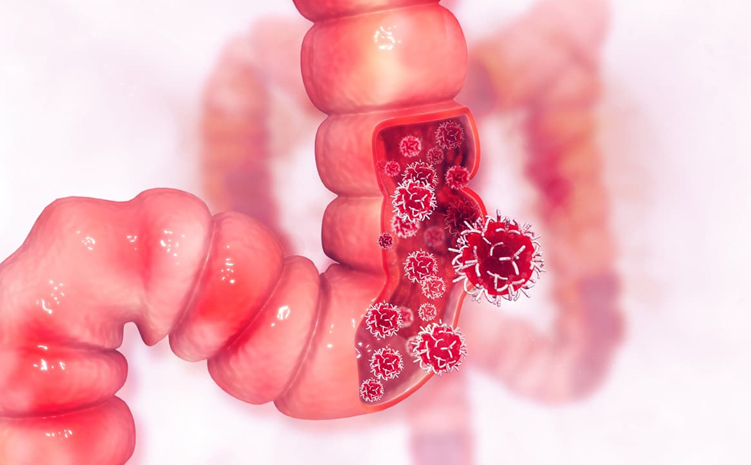Colon Cancer in Numbers
Colon cancer is an important health problem in the world and in our country. When we look at the Ministry of Health data, it is the 3rd most common type of cancer in both genders in terms of frequency. Unfortunately, colorectal cancer is the second most common cause of death in our country. In our country, 15000 new cases are detected every year. We lose approximately 7200 citizens annually to colorectal cancer.
Approximately 80-85% of all colorectal cancers occur in people over the age of 50. However, it should not be forgotten that 15-20% of the patients are young patients under the age of 50. In recent years, we have seen that the numbers, especially in the young patient group, have increased statistically. The frequency of rectal cancer is increasing, especially in the young patient group. All colon cancers, that is; 70% of colorectal cancers are located in the colon and 30% are located in the rectum. This ratio gives very similar figures for both genders. When we look at the location of colon cancers, we see that left colon tumors are the most common, and this rate is approximately 30%. Approximately 60% of colorectal cancers appear in the first 50-60 cm of the anus.
The rectum, which is approximately 15-18 cm long, appears as three 6 cm sections. The first 6 cm of the anal entrance is considered the lower rectum, the 6-12 cm area is considered the middle rectum, and the location 12 cm above is considered the upper rectum.
We said that 30% of all colon cancers are in the rectum. When this ratio is divided, 10% is seen in each section, that is, the upper 33%, the middle 33%, the lower 33%. 10% of all chlorectal cancers are located in the lower rectum, 10% in the middle rectum, and 10% in the lower rectum.
What are the symptoms of Large Intestine (Colorectal Cancer) Cancers?
Colon cancer, that is, colorectal cancer, is an important health problem both in the world and in our country today, and has been reported as the 3rd most common type of cancer in both genders, that is, men and women.
In answering the question of which symptoms occur with large intestine cancers, the region of the large intestine where the tumor is located and its extent are extremely important. Colon cancers are mostly located on the left side of the large intestine, called the left colon, and in the upper part of the anus, where the large intestine expands, called the rectum. Cancers located in this region usually cause symptoms such as anal bleeding, bloody defecation, change in toilet habits, constipation and diarrhea. Especially in cancers located in the rectum, the lack of a feeling of relief despite the patient defecating is an extremely important symptom that should be examined. Medically, this finding is called tenesmus.
In cancers that appear in the large intestine after the junction of the small intestine and the large intestine, in the initial location of the large intestine, anemia and related symptoms are observed as a result of invisible but hidden bleeding from the anus. In other words, patients experience symptoms such as weakness, fatigue, palpitations, and easy fatigue due to anemia. In large intestine cancers, the lumen of the large intestine may become obstructed as the disease progresses; It can manifest itself with constipation, cramp-like pain in the abdomen, problems with defecation and gas passing.
As colon cancer progresses, weight loss will be added to the symptoms.
What are the Risk Factors for Colon Cancers?
Large intestine cancers (colorectal cancers) are an important health problem all over the world and in our country. According to the data of the Ministry of Health, colorectal cancer is the 3rd most common type of cancer in both genders in our country. We see a large group of colon cancers in people over the age of 50, that is, in older ages. However, it is scientific data that the frequency of colorectal cancer has increased in the young patient group under the age of 50 in recent years. It is thought that the time it takes for colorectal cancers to develop on the basis of polyps and turn from normal, healthy benign polyps to colon cancer is approximately 5-10 years. This period is approximately 3-4 years for hereditary and genetically inherited colorectal cancers. Although colon cancers develop on the basis of polyps, not all colon polyps become cancerous. It is known that approximately 5% of all polyps turn into cancer.
It is possible to examine risk factors for colon cancer in two main groups. The first group of these are risk factors that can be corrected. Another group is risk factors that are independent of the person and cannot be changed.
One of the most important causes among modifiable risk factors is obesity. Today, scientific data has shown that obesity is a risk factor for colon cancer. Therefore, it is a fact that the patient's high physical activity, exercise, and avoiding a sedentary life reduce the risk of colon cancer. Nutritional habits are a very important influence on colon cancer. Regular consumption of red meat, especially the habit of frying and cooking at high temperatures, and the use of animal fats are risk factors for colon cancer. Therefore, following this diet will reduce the risk of large intestine.
The second important point to emphasize in nutrition is that the risk of consuming high fiber foods decreases. It has been scientifically proven that smoking and excessive alcohol consumption are among the correctable risk factors for colorectal cancer. Apart from all these risk groups, there are also risk factors that the person cannot correct. The first of these is advanced age. Having a history of polyp or colon cancer in the patient himself or in his close relatives, the presence of inherited colon cancer syndromes in the individual's family, and Type 2 diabetes are among the unchangeable risk factors.
Since colon polyps, which are the precursors of colon cancer, and early-stage colon cancers do not cause symptoms, the screening test is extremely important and is the biggest proof that colon cancers are preventable.
Individuals over the age of 50, those with a personal or family history of colon cancer and polyps, and those with inflammatory bowel disease must be followed up with screening tests as they are at risk.
Screening tests for colon cancer;
- Occult blood in stool
- Large intestine films
- Endoscopic interventions such as colonoscopy and rectosigmoidoscopy.
Determination of Risk Groups and Follow-up Recommendations in Colorectal Cancers
Any individual in society generally falls into the medium risk group. If there is no history of colon polyps or cancer in your family or yourself; Even if relatives outside the family, such as cousins, aunts or uncles, have a history of polyps or cancer, these patients are in the general risk group in the population, that is, the average risk group. It is recommended that this patient group be followed up with a colonoscopy every 10 years, starting at the age of 50. Or, annual fecal occult blood of individuals in this group and endoscopy every 5 years, called rectosigmoidoscopy, in which the first 30 cm section is scanned, would not be wrong.
When determining your risk group, the age at which colorectal cancer is diagnosed in your close relatives, that is, your parents or siblings, is also extremely important. For example, consider an individual whose parents or siblings are over 60 years of age and have colon polyps or cancer. Since the genetic risk is considered due to the advanced age of diagnosis, the risk is lower than the younger age of diagnosis. . What do we mean? The younger the age at which your close relative was diagnosed with colorectal cancer, the higher your risk will be.
The risk of colon in the low risk group is twice as high as in the average risk group. Therefore, clonoscopy should be performed every 10 years after the age of 40. Those who have a history of polyp or colorectal cancer in themselves and their first-degree relatives such as parents and siblings, and if the age of diagnosis in this group is before the age of 40, we put these individuals in the medium risk group. Colonoscopy should begin 10 years before the age at which parents or siblings are diagnosed.
If an individual has a history of colon polyp or cancer in 3 or more relatives in his family and it has been shown that at least two generations are affected and the age at diagnosis of one of the patients is under 50, we define these patients as Hereditary Nonpolyposis Colorectal Cancer as Amsterdam diagnostic criteria, which is The patient is in the high-risk group and his physician should start performing colonoscopy at the age of 20. Colonoscopy is recommended after the age of 20 if the patient has FAP (familial adenomatosis polyposis) or more than 10 adenomatous polyps in addition to a family history of polyps.
When should a colonoscopy be performed?
It is extremely important for individuals in the risk group to have a colonoscopy for screening purposes, especially in terms of colorectal cancer. Moderate, low, medium and high risk groups are defined. Today, it has been scientifically determined how often these risk groups should have colonoscopy.
Apart from individuals in this risk group, individuals in the normal population need to have a colonoscopy for some complaints. Colonoscopy would be a correct approach, especially in cases of rectal bleeding, changes in toilet habits, unexplained blood loss in the development of chronic diarrhea, and long-term cramp-like pain in the abdomen along with constipation. Of course, considering patients with this complaint individually; Some factors such as the patient's age, weight loss and fatigue complaints should also be taken into consideration by the physician. In addition, it is recommended that a colonoscopy be performed every 10 (ten) years, starting at the age of 50 (fifty), even if an individual in the normal population is not in any risk group in terms of the risk of developing colorectal cancer.
The Importance of Screening and Polypectomy in Colon Cancers
After scientists removed the polyps in the large intestine lumen through a procedure called polypectomy and revealed that the tumor developed on the basis of the polyp, it was revealed that colorectal cancer is actually a preventable type of cancer. Therefore, individuals in risk groups need to be screened regularly.
In a very important study based in America and England on how much the polypectomy procedure, that is, the removal of polyps during the colonoscopy procedure, protects against colorectal cancer, the expected incidence of this cancer is; It has been shown to decrease significantly after polypectomy. Another study showed that the colorectal cancer mortality rate in patients without any screening was reduced by approximately 53% in patients with regular follow-up and polypectomy. Screening for colon cancer is extremely important. While early-stage colorectal cancers are detected at a rate of only 12% in groups that are not screened, this rate increases to approximately 38% in the group that is regularly screened and polypectomy is performed.
Therefore, in colonoscopies performed for screening purposes, we can both detect the disease at an early stage and treat it with polypectomy. In patients detected at this early stage, the patient is protected from treatments that have an extra burden of complications such as chemotherapy and radiotherapy.
Do Colon Polyps Carry a Cancer Risk?
Polyps form when the mucosa, which lines the inner layer of the large intestine, grows towards the inner part of the large intestine over time. Today, we know that colon cancers develop on the basis of polyps. However, cancer does not develop from all polyps in the intestine. We know that cancer is seen in only 5% of polyps seen in the large intestine.
Polyps generally increase with age. As a result of the polyps formed in the large intestine lumen growing over time and the cells on the polyp turning into bad degenerations, cancer develops on the basis of the polyp. It is accepted that the time it takes for a polyp to turn into cancer is approximately 5-10 years.
The risk of cancer is higher in some types of polyps. The larger the polyp, the wider its base covers the intestinal wall, the greater the number of polyps, the closer it is to the anus in the large intestine, and the more degeneration there is in the cells lining the polyp's surface, the higher the risk. In light of all these reasons, it is extremely important for groups at risk of colon cancer to have regular check-ups.
How Long Does It Take for Cancer to Develop on the Base of a Polyp?
We know that colon cancers develop on the basis of polyps. So how long does it take for a baby to turn cancerous? This period is thought to be approximately 5-10 years. However, in individuals with a history of hereditary colorectal cancer, this period may be reduced to 3-4 years.
Rates of Family History in Colon Cancers
Approximately 70% of colon cancers are sporodic cases. So it's random. There are no genetic links identified within this group. Approximately 25-30% are familial colorectal cancers.
In this group, there is a frequent family history of colon rectum cancer. 5% are hereditary colorectal cancers. In other words, it is the colorectal cancer group in which genetic transmission has been scientifically proven and demonstrated. Of this hereditary group, 1% consists of familial adenomatous polyposis (FAP) and 4% consists of HNPCC syndromes.
What are the Ways of Large Intestine Cancers Spreading in the Body?
Colon cancers develop on the basis of polyps. These cancers, which originate from the mucosa covering the innermost layer of the intestine, have many ways of spreading in the body. In general, the most important features that distinguish cancers from benign tumors are that they can spread from the tissues where they originate to other organs, that is, they can metastasize, and that the cancer tissue can enter the surrounding tissues, the surrounding blood vessels and lymphatic channels, that is, it can invade. Considering all these features, cancers can spread to other organs.
Colorectal cancers spread throughout the body through 5 different ways. The first of these is that cancer cells formed in the innermost layer of the large intestine can spread from the large intestine wall to the submucosal tissues, muscle layer and serosal surfaces, which is the membrane surrounding the outermost large intestine, and can spread to surrounding tissues and organs by exceeding these surfaces. For example, we know that it can affect the small intestine, liver, uterus or ovaries around the intestine. This is what we call direct propagation.
Again, peritoneal spread can occur by shedding of cells that exceed the large intestine wall onto the surfaces of the abdomen called peritoneum. The spread of the tumor to all peritoneal surfaces is called "peritonitis carcinomatosa".
Colon tumors can spread to distant organs and regional lymph nodes through the blood circulation by invading the blood vessels within the wall layer, or to distant organs and regional lymph nodes by lymphatic spread by invading the lymph channels. They can spread via vascular vessels, that is, to distant organs such as the liver, lungs and bones. Another way of spread is that these tumors can rarely spread to the lower parts of the intestine by cell shedding from within the lumen.
Is There a Non-Surgical Treatment for Rectum Cancers?
Today, it has been scientifically revealed that it is possible to provide non-surgical treatment in a small group of patients with rectal cancer. We see that on average 20-25% of patients are treated with chemotherapy and radiotherapy without surgery, and the disease disappears. In this patient group, it is important to follow the patient closely after treatment without surgery. It is observed that approximately 30% of this patient group has a recurrence of the disease, and surgical treatment option will be considered again.
Therefore, taking into account the patient's age, whether or not he has additional diseases, the patient's gender and additional pathologies, a non-surgical treatment method can be considered, which is not suitable for every patient.



